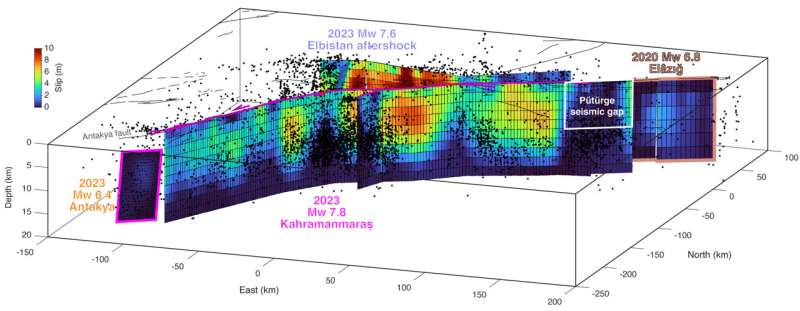This article has been reviewed according to Science X's editorial process and policies. Editors have highlighted the following attributes while ensuring the content's credibility:
fact-checked
trusted source
proofread
Turkey's next quake: Research shows where, how bad—but not 'when'

Researchers know a lot about Turkey's next major earthquake. They can pinpoint the probable epicenter, estimate its strength and see the spatial footprint of where damage is most likely to occur.
They just can't say when it will happen.
That's the main takeaway from a new USC-led study that appears in Seismica.
Using remote sensing, USC geophysicist Sylvain Barbot and his fellow researchers documented the massive Feb. 6 quake that killed more than 50,000 people in Eastern Turkey and toppled more than 100,000 buildings.
Alarmingly, researchers found that a section of the fault remains unbroken and locked—a sign that the plates there may, when friction intensifies, generate another magnitude 6.8 earthquake when it finally gives way.
"We know a little bit better what to prepare for. We don't know the timing, but we know where it can happen," Barbot said.
Major earthquakes are caused by the slipping of tectonic plates. The plates, slowly moving pieces of the earth's crust, press against each other, gradually accumulating force over the course of decades, centuries and eons. When the plates finally slip, the energy explodes in traveling waves through the earth's crust.
The Kahramanmaras, Turkey, magnitude 7.8 mainshock occurred Feb. 6, followed by a magnitude 7.6 aftershock on a separate fault further west. Another quake occurred two weeks later, a magnitude 6.4 on Feb. 20. A plotting of data (see above) shows seismic activity and the amount of slippage along the faults.
The area beneath Turkey's Pütürge district shows a swarm of seismic activity along the fault—but no slippage. That means that part of the fault is locked, or stuck, but it is likely to slip sometime—anytime— in the future.
"What we've seen in photos of the buildings that collapsed is that some of them were pancakes but others were literally pulverized," Barbot said. "So that means another degree of failure; even the concrete itself disintegrated. There is the possibility that this earthquake produced more shaking than was anticipated in the building codes. We won't know without more research.
"So, we have this region where we can expect a 6.8 magnitude earthquake and two things can happen from here. The population needs to be prepared for that. But also the scientific community because that gives us an opportunity to prepare a monitoring experiment to see how an earthquake starts and ends."
More information: Sylvain Barbot et al, Slip distribution of the February 6, 2023 Mw 7.8 and Mw 7.6, Kahramanmaraş, Turkey earthquake sequence in the East Anatolian Fault Zone, Seismica (2023). DOI: 10.26443/seismica.v2i3.502
Provided by University of Southern California





















